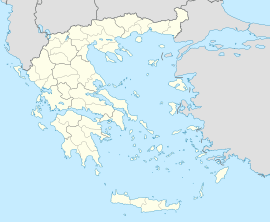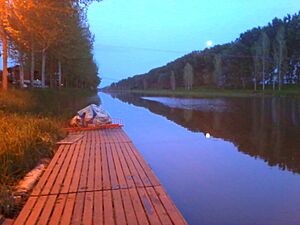Giannitsa facts for kids
Quick facts for kids
Giannitsa
Γιαννιτσά
|
|
|---|---|
 |
|
| Country | Greece |
| Administrative region | Central Macedonia |
| Regional unit | Pella |
| Municipality | Pella |
| • Municipal unit | 208.1 km2 (80.3 sq mi) |
| Elevation | 42 m (138 ft) |
| Population
(2021)
|
|
| • Municipal unit | 32,410 |
| • Municipal unit density | 155.74/km2 (403.37/sq mi) |
| Community | |
| • Population | 30,498 (2021) |
| Time zone | UTC+2 (EET) |
| • Summer (DST) | UTC+3 (EEST) |
| Postal code |
581 00
|
| Area code(s) | 23820-2 |
| Vehicle registration | EE |
| Website | www.giannitsa.gr/ |
Giannitsa is the biggest city in the Pella region of northern Greece. It's also the main city of the Pella municipality. You can find it in the Central Macedonia area.
The Giannitsa municipal unit covers about 208 square kilometers. Around 32,410 people lived here in 2021. The city is in the middle of Macedonia, between Mount Paiko and the Giannitsa plain. It's a key place for business, trade, and industry in the Pella region. A major road, European route E86 (Greek National Road 2), runs south of the city.
Long ago, there was a shallow, swampy lake called Giannitsa Lake (or Loudias Lake) south of the city. It was connected to the Loudias River. Between 1928 and 1932, a company from New York drained this lake.
About 7 kilometers from Giannitsa, you can find the old ruins of Pella. This was the birthplace of Alexander the Great and the capital of ancient Macedonia. Giannitsa is also about 48 kilometers away from Thessaloniki, a large city in Greece.
Contents
What's in a Name?
The city was first built around 1383-1387. It was called Yenice-i Vardar in Ottoman Turkish, which means 'new town of Vardar'. Sometimes, people also called it Evrenos Beg yöresi, meaning 'Evrenos Bey's town'.
The Turkish name, Yenitsa (Γενιτσά), was used until February 1926. Then, its name was changed to the Greek Giannitsa (Γιαννιτσά). In other languages, the city is known as Yenice or Vardar Yenicesi in Turkish, and Enidzhe Vardar in Bulgarian and Macedonian.
How Many People Live Here?
This table shows how the population of Giannitsa has changed over the years:
| Year | Population |
|---|---|
| 2021 | 30,498 |
| 2011 | 29,789 |
| 2001 | 29,364 |
| 1991 | 22,504 |
| 1981 | 23,966 |
| 1971 | 21,188 |
| 1961 | 19,693 |
| 1951 | 16,640 |
| 1940 | 12,964 |
| 1928 | 9,128 |
| 1913 | 7,167 |
A Look Back in Time: Giannitsa's History
Ancient Times
The area where Giannitsa is today has been lived in for a very long time! In a place called "Old Market," on a hill, people found signs of a settlement from the Early Neolithic period (around 7,000 to 6,000 BC). Giannitsa was also home to people during the Bronze and Iron Ages.
Later, in the Hellenistic period (323-30 BC), people still lived here. We know this from old coins, writings, and sculptures found in the area. In ancient times, this region was known as Bottiaea. Close to Giannitsa were the ancient cities of Pella and Kyrros.
Ottoman Rule
The city of Giannitsa became very important when it was founded by Gazi Evrenos around 1383-1387. It became a base for his warriors, called ghazi, who helped take over Macedonia and later Albania. Under the Ottomans, the city was known as Vardar Yenicesi or Yenice-i Vardar.
In the 1400s and 1500s, Giannitsa was a major cultural and religious center for the Ottomans. Many mosques, schools, and charity projects were built. In 1519, the city had many Muslim, Christian, and Jewish families living there.
During this time, the Persian language was widely spoken and studied in Giannitsa. It was so popular that the Ottomans even called the local Persian "Rumelian Persian." Many learned people, like scholars and writers, visited Giannitsa, making it a lively place for Persian language and literature.
In the early 1900s, Giannitsa became a place of conflict between Bulgarian and Greek fighters during the Macedonian struggle. The novel Secrets of the Swamp by Penelope Delta tells a story about this time from the Greek side.
Balkan Wars

Giannitsa kept its strong Turkish character until 1912. The family of Evrenos even lived in a large palace in the city center until then. During the First Balkan War, the Battle of Giannitsa on October 20, 1912, was a very important battle for the Hellenic Army (the Greek army).
German Occupation during World War II
The German army entered Giannitsa on April 11, 1941. On September 16, 1943, the city's mayor and local soccer teams organized a protest. They gave the German commander a message against the Germans' plan to give Central Macedonia to the Bulgarians.
On November 13, 1943, the Germans arrested about 50 people. They took them to a camp in Thessaloniki and killed thirteen of them. The Germans also attacked the nearby village of Eleftherohori, stealing and destroying things. On March 23, 1944, this village was burned down, and 19 people lost their lives.
On September 14, 1944, a terrible event happened in Giannitsa. About 120 residents were killed by German forces and some Greek units. The mayor, Thomas Mangriotis, was among those killed. A Swedish ambassador reported that one-third of the city was destroyed by fire. Many citizens left the city. A Red Cross representative who visited Giannitsa after the killings said it was "already a dead city." The Germans finally left Giannitsa on November 3, 1944.
Cool Places to See in Giannitsa
Historical Buildings and Sites

Giannitsa was an important city during the Ottoman period, and many old buildings still stand today. These include:
- The Tombs of Gazi Evrenos (built in 1417) and Gazi Ahmed Bey.
- The Kaifoun Baths.
- The Great Mosque.
- The Army Mosque.
- The hammam of Evrenos (a traditional bathhouse).
- The Clock Tower, built between 1667 and 1668 by the Ottomans. This tower was placed in a spot where they could watch over trade in the city and the wider region.
The Greek Archaeological Service has declared these monuments as historical sites.
Other interesting places include the Cathedral Church of Giannitsa (finished in 1860), the modern Neoclassical Multicenter, the Filippeio tourist center, ancient Macedonian tombs, and the prehistoric settlement of Archontiko.
Museums to Explore
- The Folklore Museum of Giannitsa: This museum opened in 1977. It was created by the "Philippos" History and Folklore Association to show off the local history and traditions of the area.
- The Military Museum of Giannitsa: Opened in 2012, this museum displays photos, texts, weapons, uniforms, and medals. It focuses especially on the Battle of the Swamp and the Balkan Wars of 1912–1913.
Statues and Memorials

- Black Statue - The Memorial of Giannitsà: This statue was put up in 1926 at the eastern entrance of the town. It honors the Battle of Giannitsà.
- Mass Grave: This is a list of the people who were killed by German troops at the 1st Primary School on September 14, 1944.
- Alexander the Great: A statue of Alexander the Great was revealed near the Cultural Center on October 20, 2009. This date marks the city's liberation and the Day of the Macedonian Struggle.
- Philip II of Macedon: You can find a statue of Alexander the Great's father, Philip II, in the park of the "Filippio" tourist center. Near it, there's a carving showing the Macedonian phalanx, a famous ancient army formation.
- A bust of the hero Gonos Yiotas is in Gonou Yiota Square.
Aravissos Springs
About 10 kilometers northwest of Giannitsa are the Aravissos springs. These springs provide drinking water. The area around them has a popular park with trees and a creek.
Giannitsa's Economy
Giannitsa is mostly a farming area. When the Giannitsa Lake was drained, it left behind very rich soil. This made the land great for agriculture and helped the population in the region grow.
Fun Things to Do
The main place for social life in Giannitsa is the central pedestrian street. People gather here to eat, drink, or just take a walk. Giannitsa was one of the first cities to have an Open Theatre with 3,000 seats. Every year, in the last month of summer, this theater hosts a cultural festival with famous performers. Smaller theater and music events also happen in a modern indoor theater at the Cultural Centre. In early September, there's a big market that lasts about a week.
The DI.K.E.P.A.P. is a non-profit group that started in 1996. It helps develop music, visual arts, dance, film, and other arts in the city.
The Loudias River
About 7 kilometers south of the city center is the Loudias River. This river has a sailing center. The Nautical Club of Giannitsa (NOG) teaches sports like canoeing, kayaking, and rowing.
Neighborhoods of Giannitsa
Giannitsa is made up of several neighborhoods, including:
- Center
- St. George
- Ayía Paraskeví
- Sfageia
- Sinoikismos
- Mitropoli
- St. Konstantinos
- Tsali (Nea Trapezounta)
- Filippeio
- Kapsali
- Palaia agora
Local News and Media
Newspapers
- O Logos tis Pellas (a weekly newspaper)
- Giannitsa (a daily newspaper)
TV Station
- Pella TV
Online News
- Pella24
- Pellanet
- Giannitsa City news
- Logos Pellas
Sports in Giannitsa
The most popular sports team is the Anagennisi Giannitsa football (soccer) team. They play at the Municipal Stadium.
Northwest of the city, near Mount Paiko, there's a motocross track. Local, Greek, and even European races are held there.
On the Loudias River, the Nautical Club takes part in rowing races.
Sister Cities
Giannitsa has special partnerships with three other cities around the world:
 Larnaca, Cyprus, since 2003
Larnaca, Cyprus, since 2003 Crotone, Italy, since 2010
Crotone, Italy, since 2010 New Britain, Connecticut, United States, since 2010
New Britain, Connecticut, United States, since 2010
Famous People from Giannitsa
Many notable people have connections to Giannitsa:
- Gazi Evrenos (died 1417), who founded the Ottoman city.
- Hayreddin Barbarossa (1478-1546), a famous Ottoman admiral whose father was from Giannitsa.
- K̲h̲ayālī (died 1556), an Ottoman poet.
- Āgehī (died 1577), another Ottoman poet and historian.
- Georgios 'Gonos' Giotas (1880–1911), a fighter in the Macedonian Struggle.
- Sotirios Gotzamanis (1884-1958), a doctor and politician.
- Ioannis Kourkourikis (born 1971), a Greek Olympic rower.
- Melina Aslanidou (born 1974), a singer who grew up in Giannitsa.
- Elisavet Mystakidou (born 1977), a Greek Olympic silver medalist in taekwondo.
- Monsieur Minimal (born 1980), an indie pop music composer.
- Effie Achtsioglou (born 1985), a politician.
- Dimitris Pelkas (born 1993), a soccer player.
- Giannis Michailidis (born 2000), a soccer player.
Images for kids





















